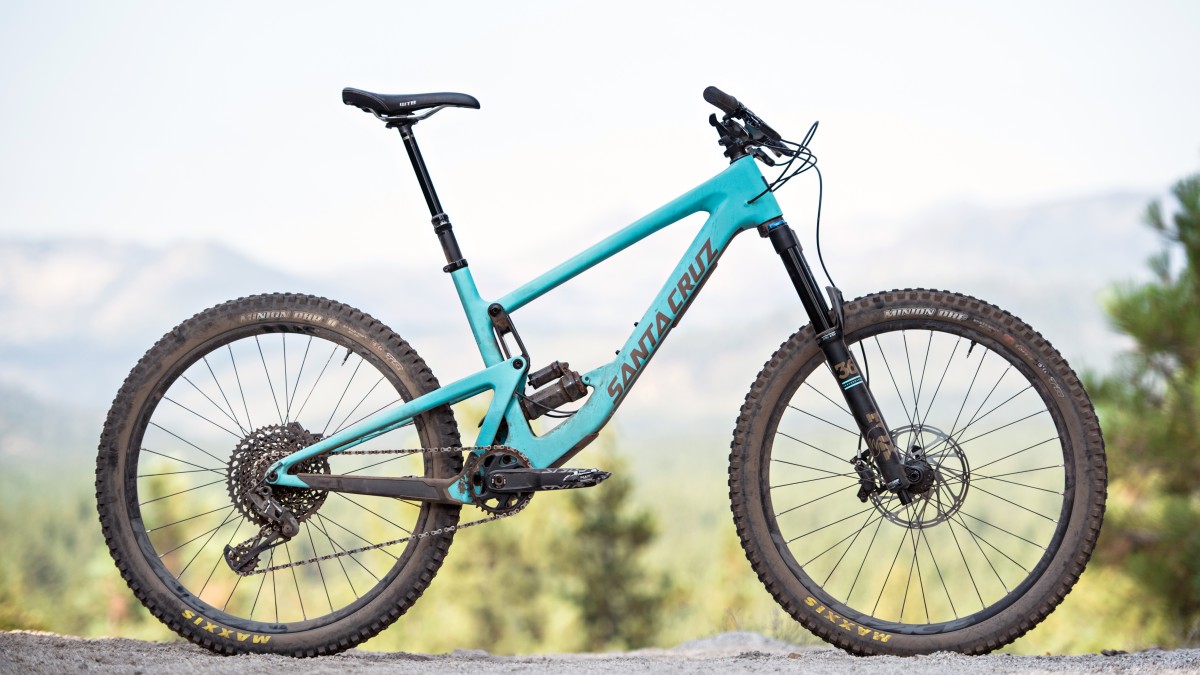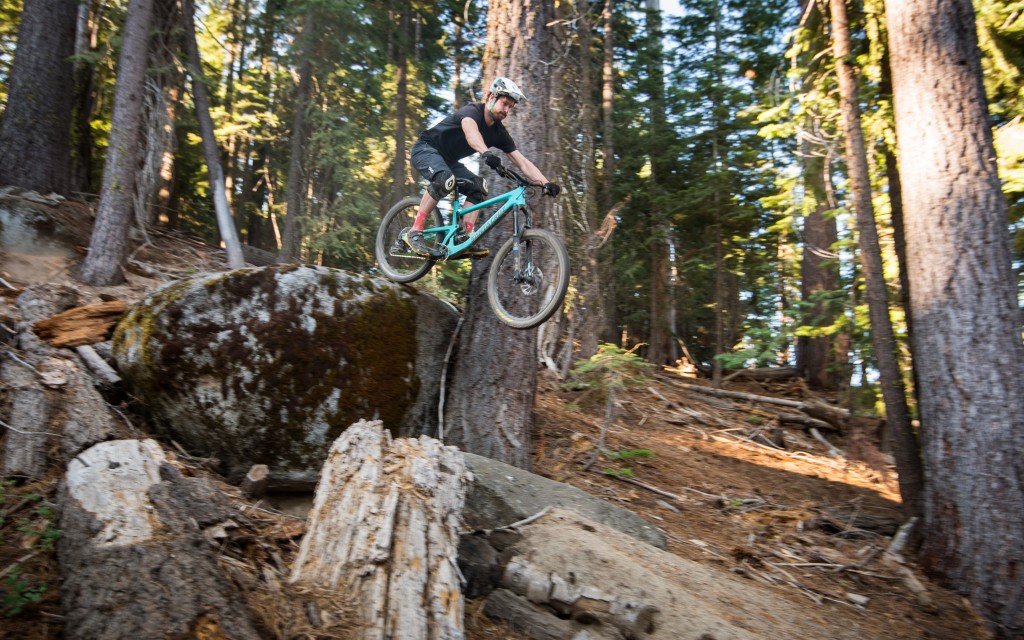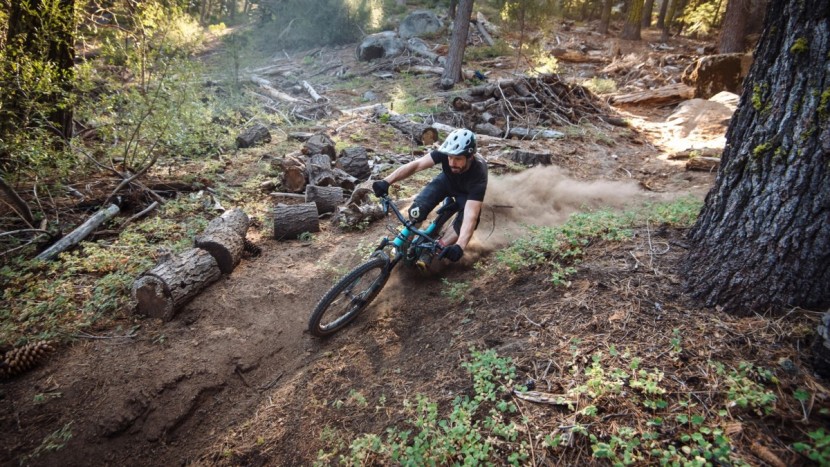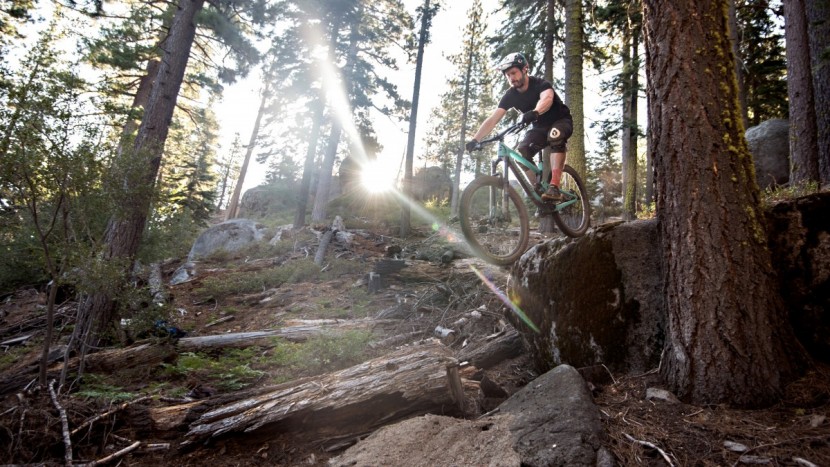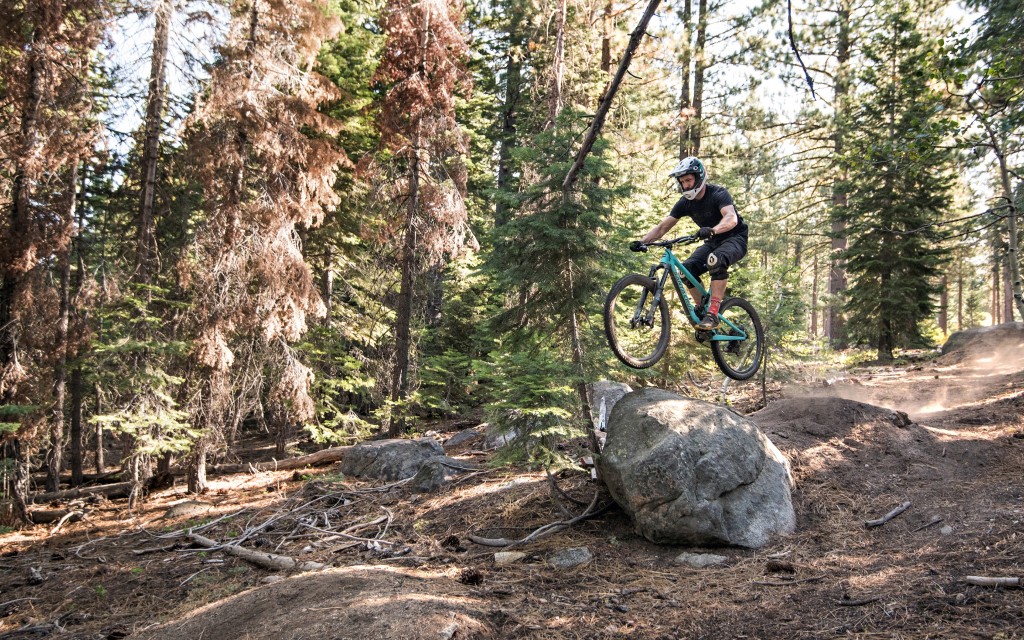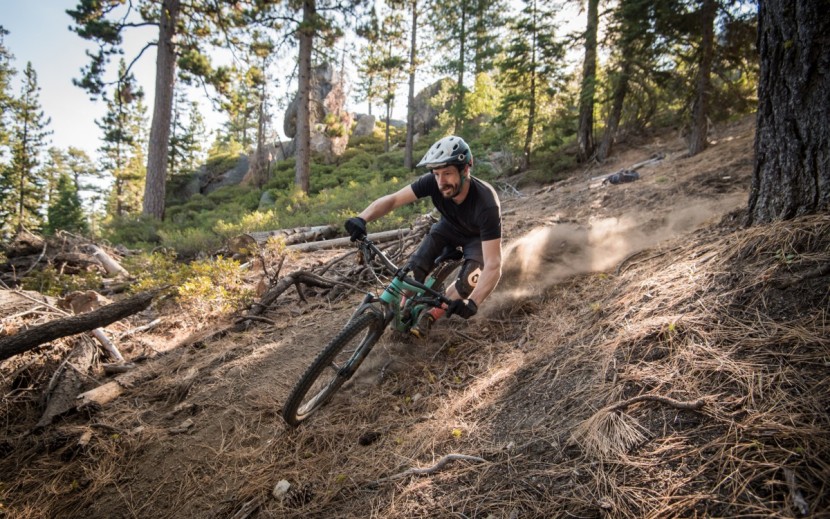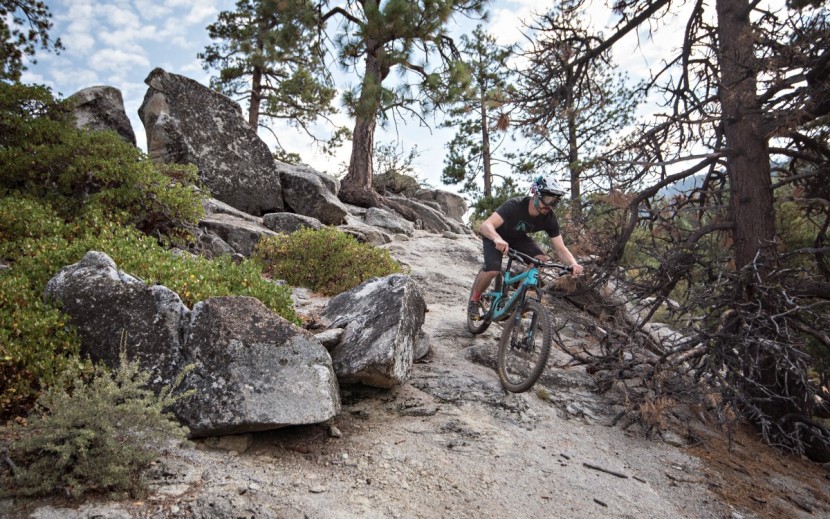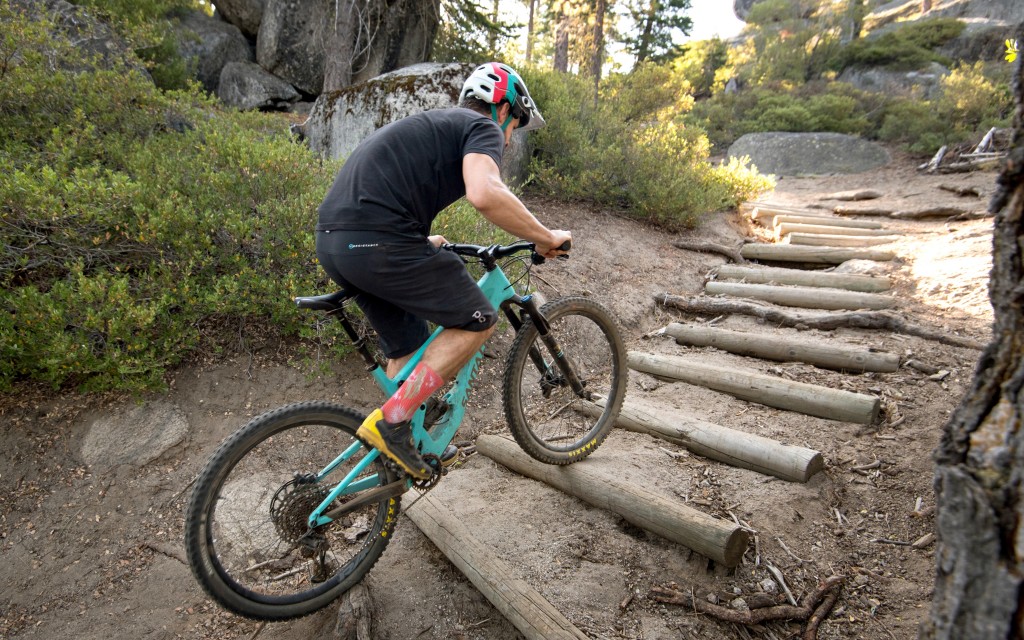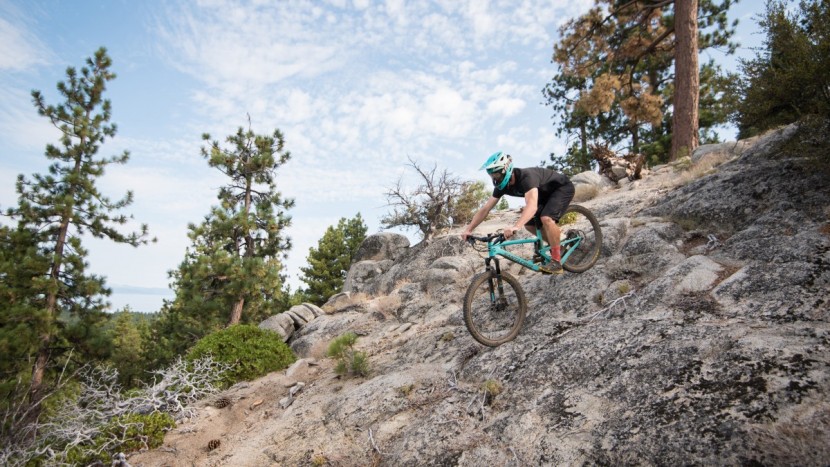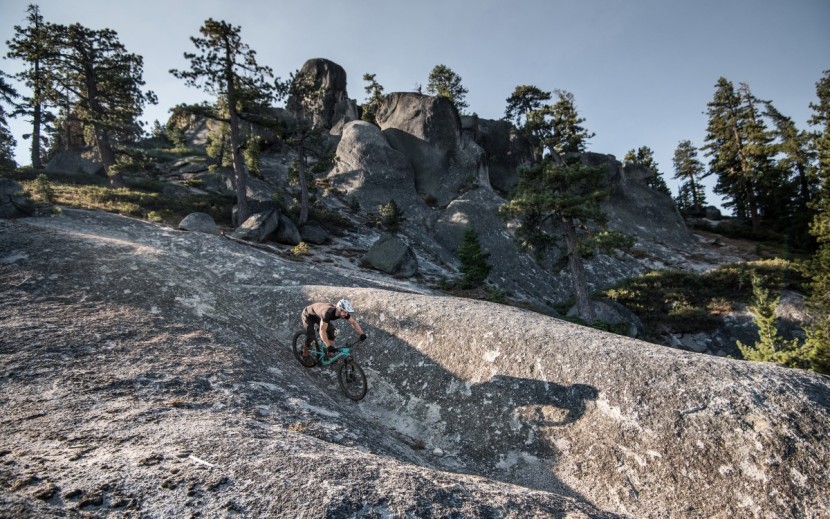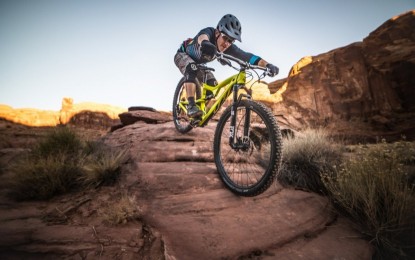Santa Cruz has updated the Bronson's colors. The Carbon S build we tested is now offered in a Red Tide/Yellow colorway. July 2019
Santa Cruz Bronson Carbon S Review
Our Verdict
Santa Cruz has updated the Bronson's colors. The Carbon S build we tested is now offered in a Red Tide/Yellow colorway. July 2019
Our Analysis and Test Results
Should I Buy This Bike?
The Bronson is a very intriguing option for riders who prefer 27.5-inch wheels and value downhill performance above all but still want to retain respectable climbing abilities. Riders who don't want to pedal a full-blown enduro bike around will love this bike. The Bronson slays most downhills save for the true double-black diamond rock gardens. This bicycle has no problem cranking out a 4000-foot+ day of climbing although this kind of ride certainly wouldn't be our first choice. The reworked suspension layout with the lower-link shock mount delivers a slightly more linear feel and improved small bump feel. This is a significant improvement over the outgoing model.
Riders who want to save some cash and who value increased climbing performance should check out the the super affordable YT Jeffsy Base 29. The Jeffsy weighs a bit more but performs similarly to the Bronson on the descent, with excellent all-around performance. The Jeffsy only has the same travel front and rear but feels more zippy and nimble due to more conservative geometry. It's also available in both 27.5" and 29" wheel sizes. The best part? The Jeffsy starts at $2299 with a solid component specification for the price with carbon framed models ranging in price from $2,999 up to $5,299.
Want an aggressive, long-travel, 29er? The new Ibis Ripmo V2 shreds hard while retaining an athletic feel. This 147mm 29er climbs very well, descends well, and maintains a very sporty rear end. The Ripmo can't quite match the top-end downhill performance of the Bronson, but it isn't terribly far off. The Ibis is a far better climber with its steep seat tube angle and wagon-wheels. In addition, the Ripmo has a more lively and sporty rear end and feels a bit more like a beefed-up trail bike rather than a scaled-down enduro bike.
Frame Design
The Bronson has 150mm of rear-wheel travel and runs Santa Cruz' Virtual Pivot Point (VPP) suspension platform. This dual-link system has a link just above the bottom bracket and another about halfway up the seat tube. As the bike dives into its travel, the two links rotate in opposite directions. Traditionally, VPP is known for a firm and efficient pedal platform and poor small bump compliance. We found the new suspension layout improves small bump compliance significantly.
We measured our large test bike in both geometry settings.
In the high mode, our bike has a 625mm top tube and 460mm reach. The head tube angle is 65.3 degrees and the seat tube angle is 75.1-degrees. The bottom bracket height is 342mm.
In the low mode, we measured a 623mm effective top tube and a 456mm reach. The head tube angle is 65.0-degrees and the seat tube angle is 74.8-degrees. The bottom bracket height is 339mm.
The chainstays measure 432mm and the wheelbase is 1215mm. Our large test bike hit the scales and came in at 30-lbs 13 ounces set up tubeless without pedals.
Design Highlights
- Accepts 27.5-inch or 27.5-plus wheels
- 150mm rear wheel travel
- Designed around 160mm fork
- 1x drivetrains only
- Redesigned suspension layout with lower-link shock mount
- Flip-chip geometry adjustment
- Lifetime frame warranty
Downhill Performance
The Bronson is a downhill shredder that remains confident at blistering speeds. Motoring down flow trails and charging over chunder is incredibly fun. The suspension design remains composed and the new linkage feels excellent. Given the length of the bike, it isn't all that playful. Boosting jumps, stumps and rolls in the trail can be a little awkward. The Carbon S build kit works well save for the poor hub engagement on the DT 370 hubs.
We rode this bike in both geometry settings. For a bike intended to get rad, it is simply better in the low mode. Ripping this beautifully burly blue bicycle in the high setting felt a little less stable and less confident while not adding much in the ways of climbing efficiency.
The redesigned Bronson shreds much harder than its predecessor. Once this bike is up to speed it is remarkably stable and confident. You can push the Bronson pretty darn hard before it stutters. When feeding it down flow trails this bike has the nerves to go faster and faster. Make no mistake, this bike does have limitations on the truly rowdy terrain. At the bike park, some of the double-black diamond rock gardens will cause problems. This shouldn't come as a huge surprise for a bike with 150mm of travel. In these steep and chunky situations, the geometry holds up well-enough but the suspension can get overwhelmed and it is hard to hold a line.
Santa Cruz states the “new lower-link shock configuration opens up greater possibilities for maximum bump performance, a supportive mid-stroke, and a barely detectable bottom out”. In the FAQ section, Santa Cruz says "coil shocks will work on the Bronson “but we recommend an air shock. While progressive, the suspension is biased towards air shocks and not quite progressive enough to work well with a coil”. There is a lot of information floating around in those quotes. The main takeaway should be that the new Bronson is more linear with better bump compliance. We find this to be accurate on all levels. Here at OutdoorGearLab, we have tested several Santa Cruz bikes over the years and the new-Bronson, along with the new Nomad, have the best small to mid-size small bump compliance. Bikes like the old Hightower LT and the previous version of the Bronson have always stood up well to bigger hits, but motoring over chatter was never a strong suit. Much of the trail surface was transferred to the rider and it almost feels like your shock is in the firm or climb position. This new lower-link suspension layout works very well. The Bronson feels excellent over roots, small rocks, and bomb holes.
Given the less progressive/more linear design, it would be logical to think deep stroke support suffers. We found it easier to blow through the travel at 30-35% sag. We never experienced a harsh, frightening, bottom out, but you could definitely get through the travel. This may sound like a negative, but it is nice riding a bike that uses its full-travel rather than only using 70% of a bike's available travel. If you have 150mm to play with, why not use it? It does seem like Santa Cruz' recommendation to forgo a coil shock has merit.
Downhill handling is solid. The frame is stiff and it responds to minimal rider input. Dip your shoulder into a corner and the bike reacts. Slow corners and tighter sections of trail can be problematic and bit awkward given the 1215mm wheelbase.
The Bronson isn't a particularly playful bicycle. It is simply too long to want to come off the ground. This lengthy wheelbase and slack front end don't allow the bike to fit on the face of jumps all that well. When hopping off a lip, it feels like there is a long delay from when your front end leaves the lip and when the rear wheel finally makes it over. Coming off drops, this is even more disconcerting. A rider just hopping aboard the Bronson may find it takes more speed to negate this long-wheelbase on drops. This bike is far more happy hauling down your favorite single track and slaying high-speed berms.
The build kit on the $5199 Carbon S kit worked well on the descent. The Fox Performance 36 with GRIP damper is worlds better than the 34 version with the same damper. It was easy to set up the fork to balance small bump feel and deep stroke support. The RockShox Super Deluxe R is an excellent performer. The DT 370 hubs have poor engagement. When trying to slip in pedal strokes on the descent, there can be an audible clunk after you finally get through the dead spots in the hub. The Maxxis Minion DHF/DHR II combination was fantastic as always. Say what you will about the RockShox Reverb, but the 170mm drop is fantastic.
Climbing Performance
The Bronson is a decent climber given how radical it gets on the descent. There is certainly no mistaking this bike for a mid-travel bike when grinding uphill, but the suspension design is efficient and utilizes rider energy relatively well. This isn't our first choice for full-day epic rides but it scoots uphill surprisingly well. The RockShox Super Deluxe R doesn't have a climb switch which is an annoying inconvenience as it can be beneficial in certain situations.
The Bronson sets you up in a nice climbing position. The 75.1/74.8-degree seat tube angle is on the slacker side of the spectrum by today's standards. You aren't exactly smack dab on top of the crank, but you're also not terribly far behind it. Power transfer is reasonable and the 460mm reach measurement on our large bike strikes a nice balance of not stretching you out while not feeling cramped.
When putting the power down the Bronson's suspension design remains calm. With the redesigned suspension layout delivering a more linear ride and better bump compliance, we expected to see reduced climbing efficiency. This wasn't the case. If we gaze down towards the shock when grinding uphill, there is little movement. When you need to stand up and get on the gas, the suspension retains its calm feel. The slack angles don't exactly give off an ultra-efficient feel, but the bike powers uphill well enough. It wouldn't be our top choice, but we have no problem taking the Bronson on 30-mile rides with 4000-feet of climbing.
The 1215mm wheelbase creates an interesting climbing feel. In a straight line up a technical section of trail, the added length gives you a long, stable, rock crawling feel. Just line the bike up, punch it, and the Bronson goes right up and over. Tighter moves are more difficult. Rock gardens or root infested zones where you have to cut back and forth across the trail or get creative with line choice can be problematic. We wouldn't necessarily call this bike especially bulky or clumsy, but it is definitely not nimble.
The SRAM GX Eagle drivetrain was fine and the Maxxis Minions hook up very nicely on the climb. We take issue with the RockShox Super Deluxe R not having a climb switch. The suspension is calm on this bike and you don't really need a climb switch on singletrack. That said, it would still be beneficial on fire road or pavement. The technology is there for RockShox to include a climb switch on the entry-level Super Deluxe R, they should use it.
Photo Tour
Value
At $5199, the Bronson offers excellent downhill performance, respectable climbing, and the build kit is decent. This bike is an average value for the rider who wants an aggressive 27.5" bike that still climbs pretty well. The performance is definitely there, but it will cost you. Yes, the frame and suspension design is definitely dialed, but there are some interesting competitors available at significantly lower prices.
Conclusion
Santa Cruz nailed it with the all-new Bronson. This bike is perfect for the aggressive rider who wants an excellent descender that retains respectable climbing abilities. This 150mm bike in an impressive entry into the enduro-light or aggressive trail category. The Bronson is an excellent choice for the rider who values downhill performance above all but doesn't want to take the plunge to a full-blown, burly, enduro bike.


